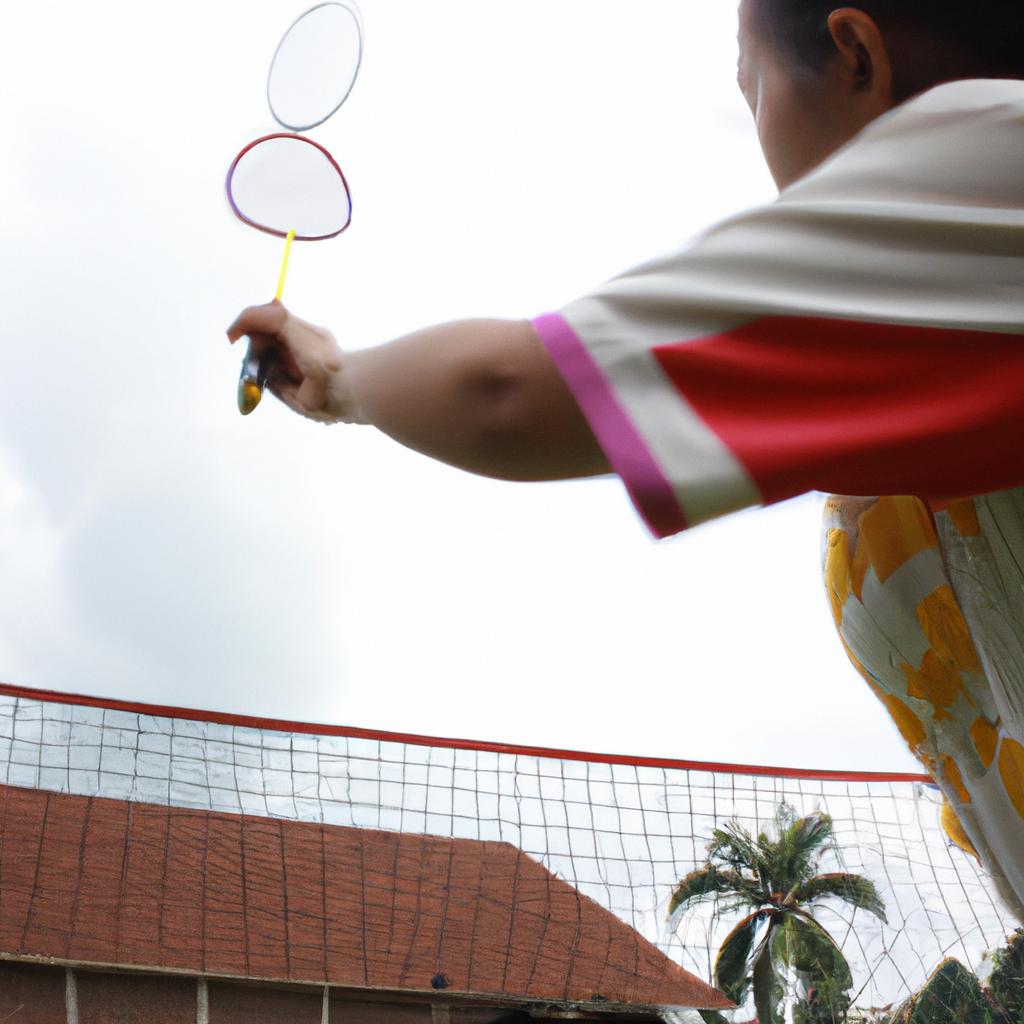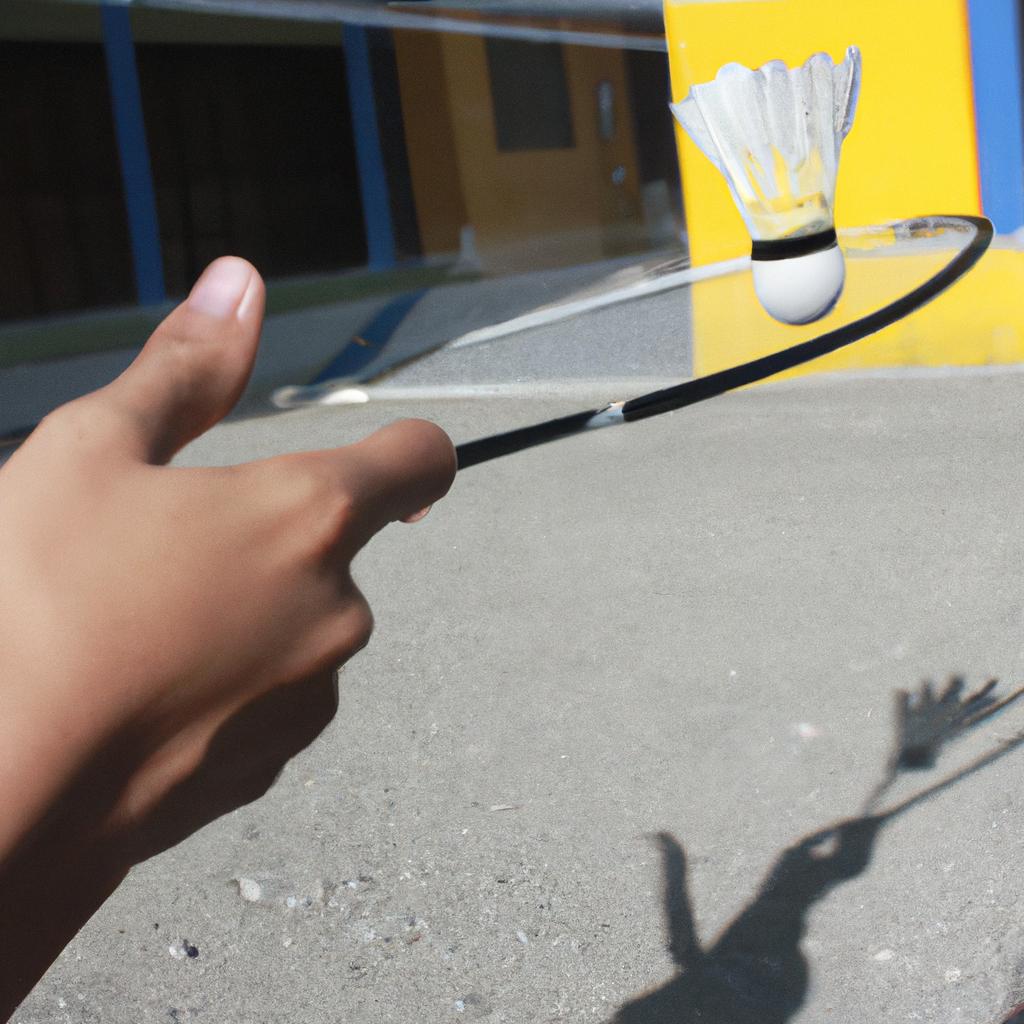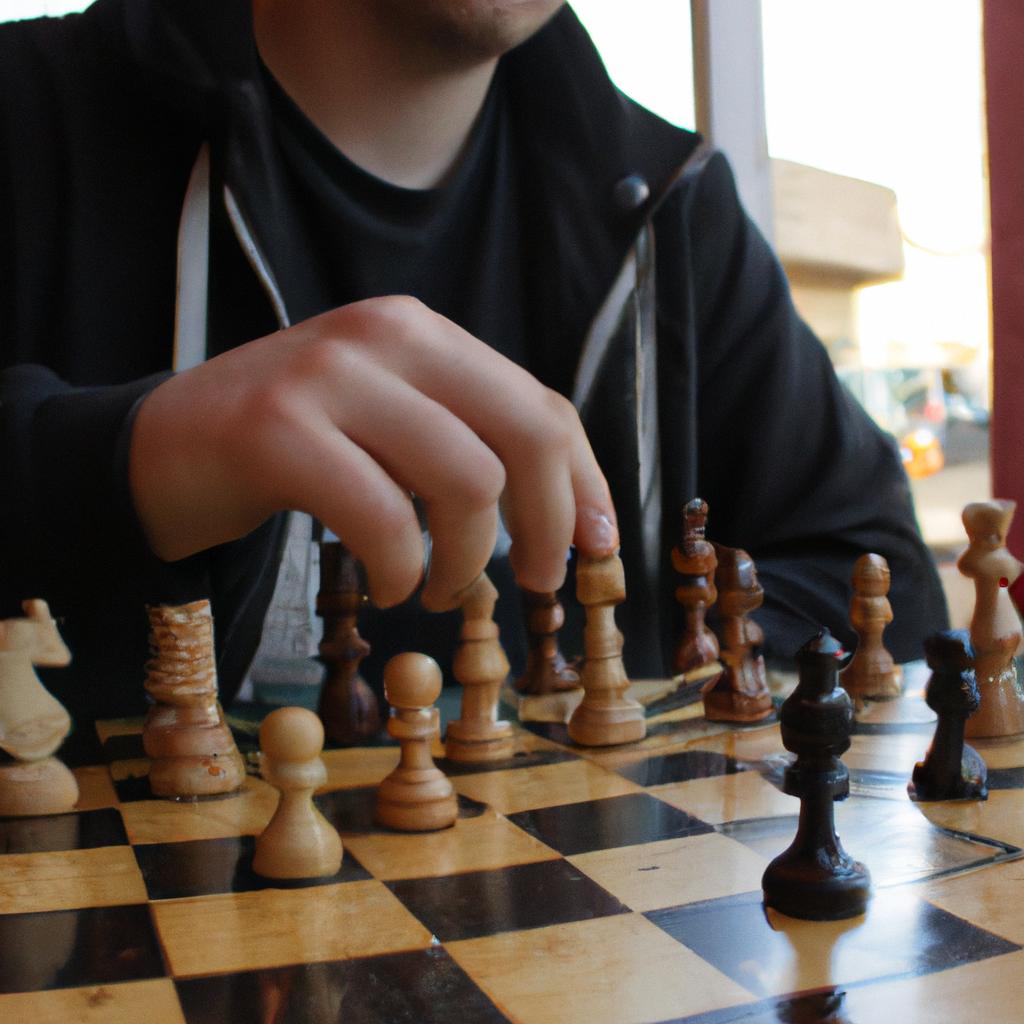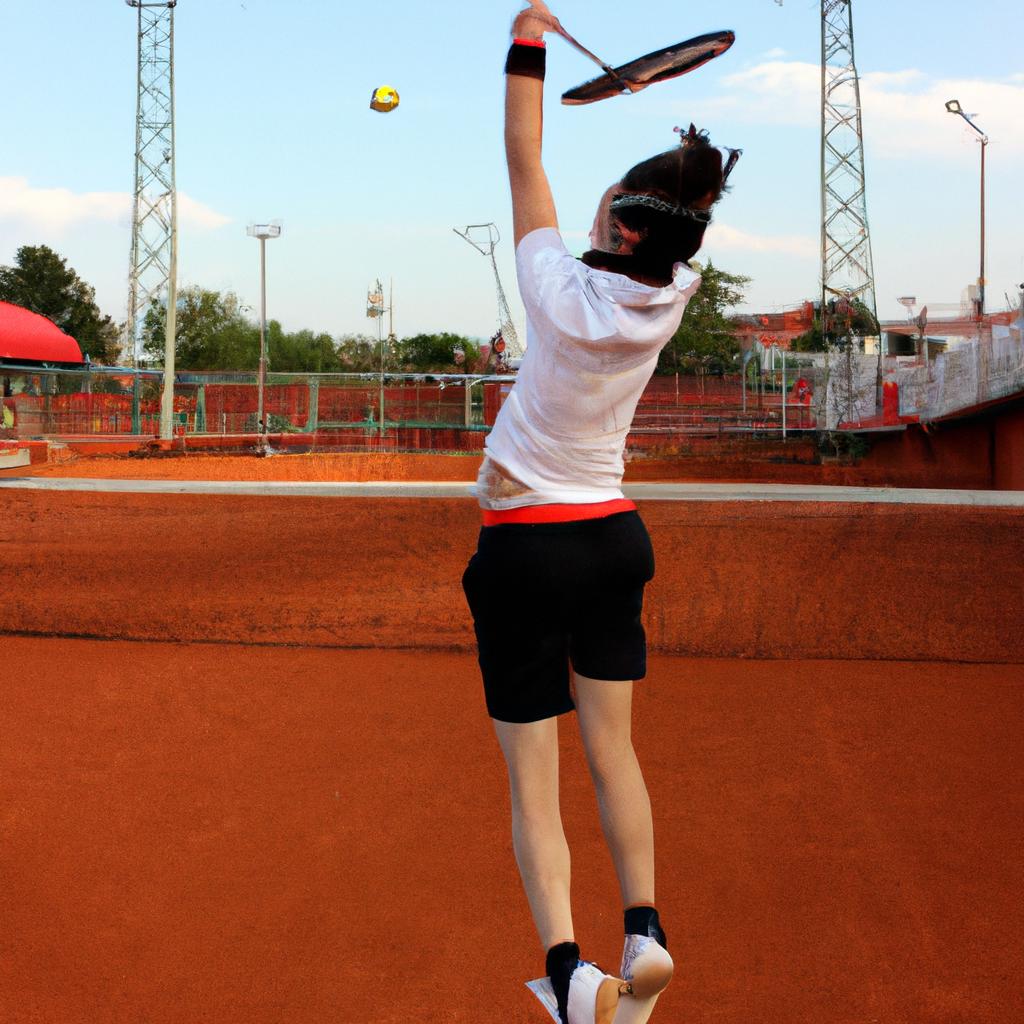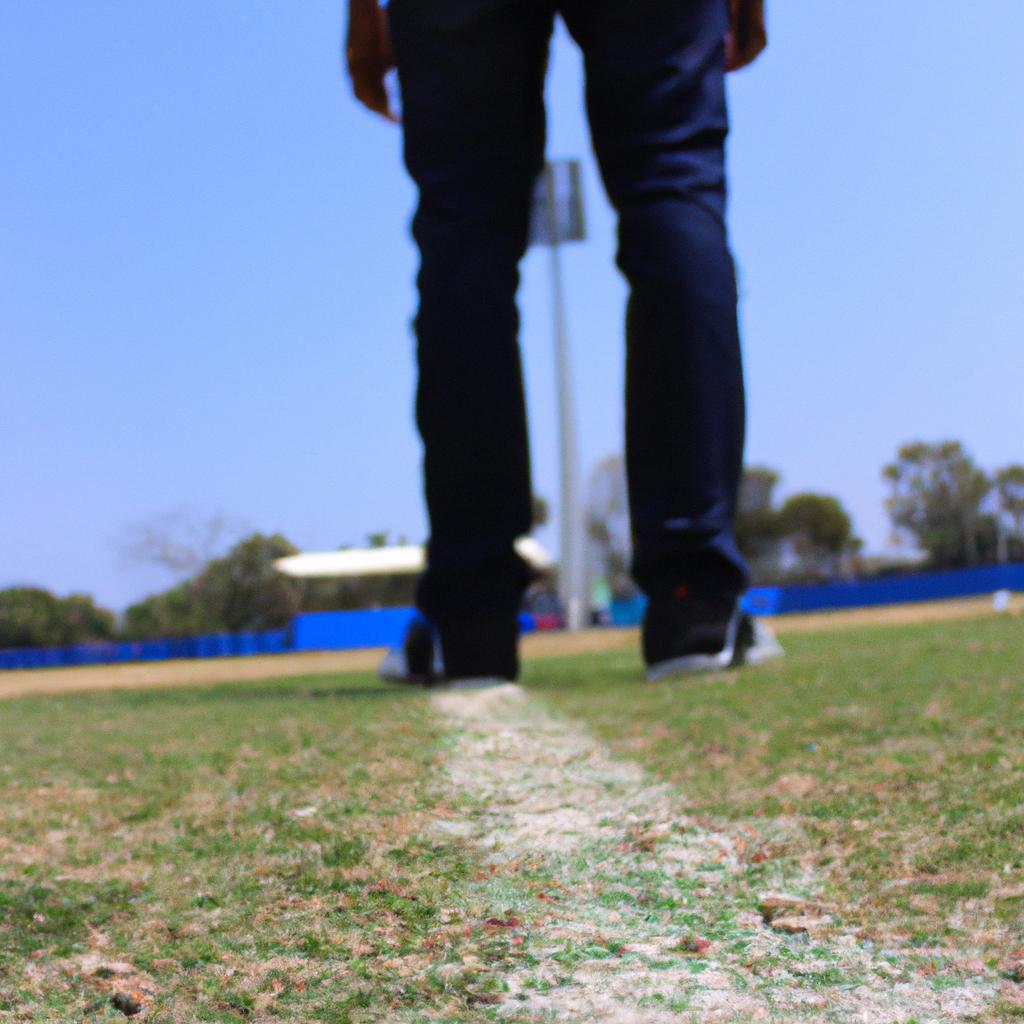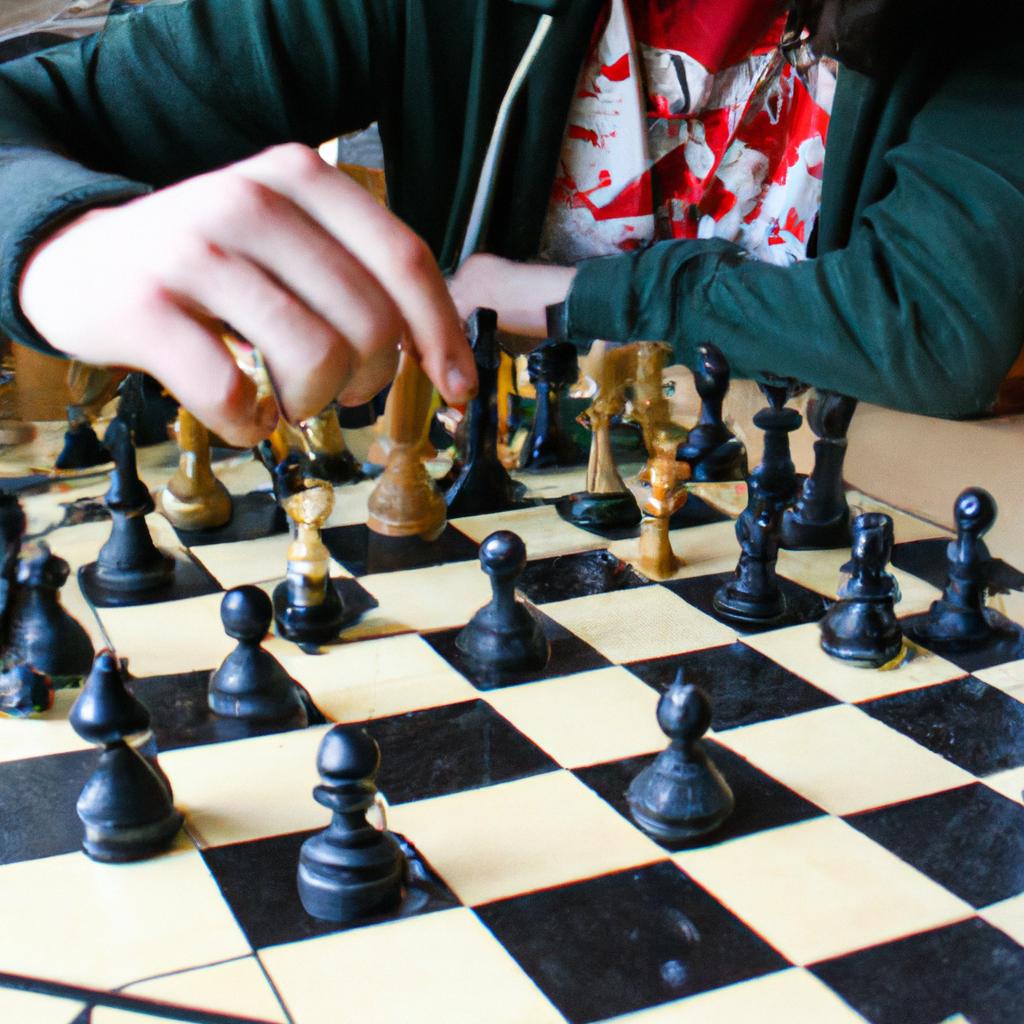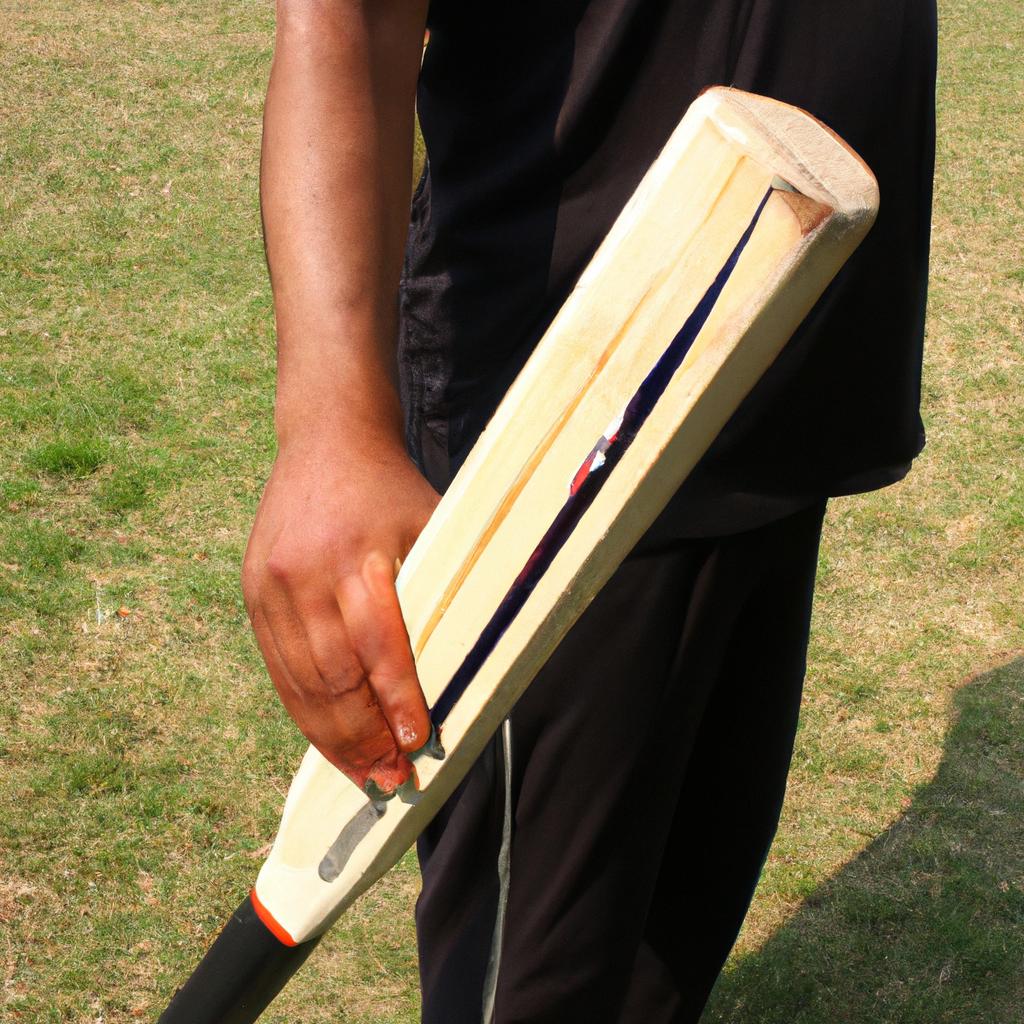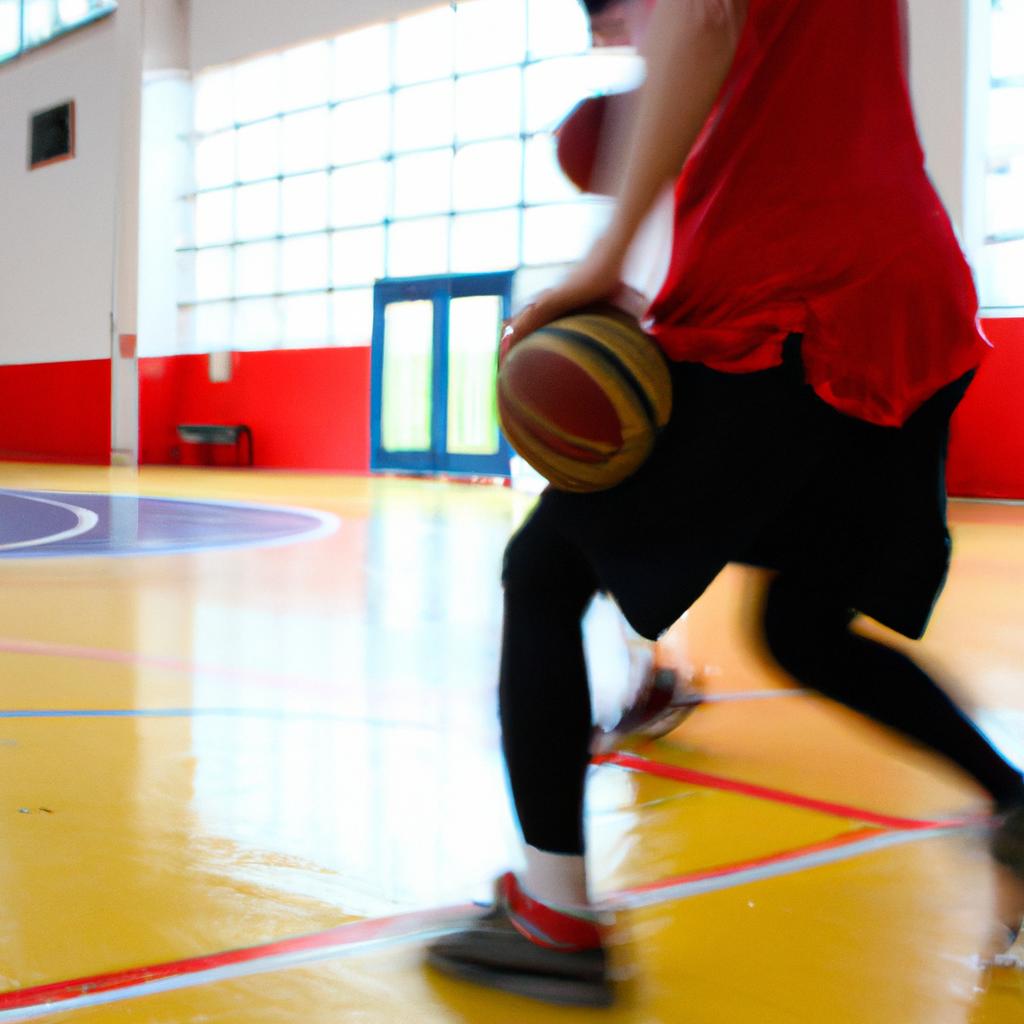Badminton is a popular sport that requires skill, agility, and strategic thinking. In the context of games and sports, it serves as an excellent example of how training can lead to success. Consider the case study of Sarah, a young badminton player who started with little experience but through dedicated practice and coaching, went on to become a champion in her local tournaments.
The significance of training in badminton cannot be overstated. Like any other competitive sport, mastering the skills and techniques necessary for success requires consistent effort and discipline. Through systematic training programs, athletes are able to improve their physical fitness, develop their technical abilities, enhance their mental focus and game strategies. By adhering to structured schedules that include regular practice sessions, physical conditioning exercises, tactical drills, and match simulations, players like Sarah are able to hone their skills and reach peak performance levels.
In this article, we will explore the various aspects of badminton training within the broader framework of games and sports. We will delve into the importance of proper coaching methods tailored to individual needs, effective training routines for both physical conditioning and technical skill development, as well as psychological preparation for high-stakes competitions. Furthermore, we will analyze how badminton training not only improves athletic performance, but also cultivates important life skills such as discipline, perseverance, and teamwork.
One of the key components of successful badminton training is having a knowledgeable and experienced coach. A good coach can provide guidance, identify areas for improvement, and design customized training programs tailored to the player’s strengths and weaknesses. They can teach proper techniques, analyze game footage to identify areas of improvement, and provide valuable feedback on strategy and tactics. A coach who understands the unique demands of badminton can help players develop their skills in areas such as footwork, racket control, shot selection, and court positioning.
Physical conditioning is another crucial aspect of badminton training. The sport requires agility, speed, explosiveness, endurance, and flexibility. Players must have the stamina to sustain long rallies and quick reflexes to react to fast-paced shots. Training routines should include cardiovascular exercises to improve endurance, strength training to build muscular power for explosive movements, plyometric exercises to enhance agility and quickness, as well as stretching exercises for flexibility. Additionally, incorporating specific drills that simulate game situations can help players improve their reaction time and decision-making abilities under pressure.
Technical skill development is equally important in badminton training. This includes mastering various strokes such as clears, drops, smashes, drives, net shots, and serves. Players must practice these shots repeatedly to achieve consistency in execution. Footwork drills are also essential for improving movement efficiency around the court. By focusing on technique through repetitive practice sessions and receiving feedback from coaches or peers during training sessions or matches helps players refine their skills over time.
Psychological preparation is often overlooked but plays a vital role in achieving success in badminton. Mental toughness is essential for handling high-stakes competitions where performance anxiety may arise. Developing concentration skills allows players to stay focused during matches even under pressure or distractions. Visualization techniques can be employed to mentally rehearse strategies or envision successful outcomes before actual competitions. Learning to cope with failures, setbacks, and maintaining a positive mindset is also crucial for long-term success in the sport.
Beyond the improvement of athletic performance, badminton training instills important life skills. The dedication and discipline required in training transfer to other areas of life, such as academics or professional pursuits. Perseverance in the face of challenges helps players develop resilience that can be applied to various aspects of life. Additionally, badminton is often played as a team sport, promoting teamwork, communication, and cooperation among players.
In conclusion, badminton training is a comprehensive process that encompasses physical conditioning, technical skill development, psychological preparation, and the cultivation of valuable life skills. Through dedicated practice and coaching tailored to individual needs, athletes like Sarah can elevate their game and achieve success in local tournaments. The lessons learned from badminton training go beyond the court and have far-reaching impacts on personal growth and development.
The History of Badminton
Imagine a scene in the late 19th century, where a group of British officers stationed in India are enjoying their leisure time. Seeking a way to stay active and entertained, they come up with an idea for a new game played with rackets and shuttlecocks. Little did they know that this humble pastime would evolve into the internationally recognized sport we now know as badminton.
Badminton’s roots can be traced back thousands of years, with games involving hitting objects with racquets found in ancient civilizations across the globe. However, it was not until the mid-1800s that badminton as we understand it today began to take shape. The development of modern materials such as lightweight rackets and feathered shuttlecocks allowed for greater speed and precision in gameplay.
To truly grasp the historical significance of badminton, let us consider its evolution over time:
- Emergence as a popular recreational activity: Initially played by European elites as an outdoor diversion, badminton quickly gained popularity among people from all walks of life due to its simplicity and accessibility.
- Establishment of formal rules: In 1873, the Duke of Beaufort codified the first set of regulations for badminton at his country estate called Badminton House. This marked a crucial turning point in the sport’s history, providing players with standardized guidelines for competition.
- Global adoption through international competitions: As interest in badminton grew worldwide, various organizations were formed to oversee its development. One notable example is the formation of the International Badminton Federation (now known as Badminton World Federation) in 1934, which facilitated global tournaments and fostered competitive spirit.
In reflecting upon these milestones, one cannot help but acknowledge how far badminton has come since its modest origins. The emotional connection between players and fans is evident when considering some key aspects of the sport:
- The exhilaration felt when executing a perfectly timed smash, sending the shuttlecock hurtling towards an opponent’s court.
- The tension and anticipation that build during a rally, as players showcase their agility and strategy to outmaneuver one another.
- The sense of accomplishment derived from mastering the intricate footwork required for swift movements across the court.
- The camaraderie formed through team play or friendly matches, where individuals bond over shared passion and mutual respect.
To delve further into badminton’s significance, it is essential to explore not only its rich history but also the crucial role played by training. In doing so, we can uncover how dedicated practice and discipline contribute to success on the badminton court.
The Importance of Training in Badminton
Transitioning from the previous section on the history of badminton, we now delve into the importance of training in this dynamic sport. To illustrate this point, let us consider an example: a young aspiring badminton player named Emily who dreams of becoming a professional athlete. Without proper training and guidance, Emily’s potential might go untapped, hindering her progress and limiting her chances of success.
Training is crucial in honing one’s skills and abilities in any sport, including badminton. It provides athletes like Emily with numerous benefits that contribute to their overall development as players. Firstly, structured training programs allow individuals to build physical strength and endurance through targeted exercises and drills specifically designed for badminton players. These sessions enhance muscle coordination and flexibility while promoting cardiovascular fitness – essential components for excelling in a fast-paced game like badminton.
Secondly, training imparts mental discipline to athletes by instilling focus, concentration, and resilience. Through regular practice sessions and competitive play scenarios, players learn how to strategize effectively during matches, adapt swiftly to changing situations on the court, and remain composed under pressure. Mental toughness gained through training equips athletes like Emily with the ability to overcome obstacles, stay motivated during challenging times, and perform at their best when it matters most.
Moreover, training offers opportunities for skill refinement and tactical awareness. Coaches provide valuable feedback on technique execution such as grip positioning or footwork patterns which can significantly impact performance outcomes. By participating in drills that simulate real match scenarios or analyzing opponents’ playing styles through video analysis sessions, players develop a deep understanding of the game’s intricacies – enabling them to make split-second decisions instinctively during intense rallies.
To emphasize the significance of training in badminton further, here is a bullet-point list highlighting some advantages:
- Improved physical fitness
- Enhanced mental discipline
- Skill refinement
- Tactical awareness
Additionally, let us visualize these benefits through a table:
| Benefits of Training in Badminton |
|---|
| Improved physical fitness |
| Enhanced mental discipline |
| Skill refinement |
| Tactical awareness |
In conclusion, training forms the bedrock for success in badminton. Through structured practice sessions and guidance from coaches, aspiring athletes like Emily can unlock their full potential on the court. The next section will explore the different techniques and skills that players must master to excel in this captivating sport.
The Different Techniques and Skills in Badminton
Section H2: The Different Techniques and Skills in Badminton
Transitioning from the previous section on training, it is crucial to understand the various techniques and skills that encompass the game of badminton. To illustrate this point, let us consider a hypothetical scenario where two players with contrasting skill sets compete against each other. Player A possesses exceptional agility and speed, allowing them to swiftly move around the court. On the other hand, Player B demonstrates excellent shot accuracy and control.
In order to excel in badminton, players must master an array of techniques and skills. Here are some key elements that contribute to success on the court:
- Footwork: Good footwork is essential for quick movements across the court, enabling players to reach shots efficiently and maintain balance during rallies.
- Grip Technique: Proper grip technique ensures maximum power generation while maintaining precision and control when executing different strokes.
- Stroke Mechanics: Mastering stroke mechanics allows players to execute a variety of shots such as smashes, clears, drops, drives, and net plays effectively.
- Court Awareness: Developing keen spatial awareness helps players anticipate their opponent’s moves better while strategically positioning themselves on the court.
To further highlight these aspects visually, we present a table showcasing how each technique or skill contributes to overall performance:
| Technique/Skill | Importance |
|---|---|
| Footwork | Essential |
| Grip Technique | Crucial |
| Stroke Mechanics | Vital |
| Court Awareness | Fundamental |
Understanding and honing these techniques will significantly enhance a player’s ability to perform well on the badminton court. By continuously practicing these skills alongside effective training strategies discussed earlier, aspiring athletes can elevate their game to new heights.
Transition into subsequent section: Now let us delve deeper into another critical aspect of badminton – The Role of Strategy and Tactics in maximizing one’s chances for victory.
The Role of Strategy and Tactics in Badminton
In the complex world of badminton, success on the court relies not only on individual skill but also on strategic thinking and tactical awareness. Understanding how to employ effective strategies and tactics can significantly enhance a player’s performance and increase their chances of winning matches. To illustrate this point, let us consider an example scenario:
Imagine a doubles match between Team A and Team B. Both teams possess similar technical abilities, with powerful smashes and precise net shots at their disposal. However, Team A has developed a well-thought-out strategy while Team B lacks cohesive tactics. As a result, during crucial moments in the match, Team A executes quick rotations and employs deceptive shots that consistently outsmart their opponents.
To achieve such mastery in badminton strategy and tactics, players must focus on several key aspects:
- Shot selection: Players need to analyze each situation carefully to determine which shot is most appropriate – whether it be a drop shot, clear, or smash.
- Court coverage: Effective positioning on the court allows players to cover all areas efficiently and exploit weaknesses in their opponents’ game.
- Communication: In doubles matches especially, constant communication between partners ensures smooth coordination and facilitates efficient decision-making during rallies.
- Adaptability: Being able to adapt one’s strategy based on the opponent’s playing style is essential for maintaining an advantage throughout the match.
To further understand these concepts visually, refer to the following table:
| Strategic Aspect | Example |
|---|---|
| Shot Selection | Utilizing drop shots against aggressive opponents |
| Court Coverage | Maintaining proper formation during defensive play |
| Communication | Signaling partner when switching positions |
| Adaptability | Adjusting tactics against opponents with strong backhand |
By incorporating these strategies into their gameplay, players gain an edge over their competitors as they strategically exploit weaknesses and capitalize on opportunities. This enables them to control the pace of the game, dictate rallies, and ultimately increase their chances of victory.
Looking ahead, let us now delve into the physical fitness requirements for badminton players, which play a crucial role in supporting these strategic endeavors.
The Physical Fitness Requirements for Badminton Players
Transitioning from the previous section, where we explored the role of strategy and tactics in badminton, let us now delve into another crucial aspect of the sport – the physical fitness requirements for badminton players. To illustrate this further, consider the case study of a professional badminton player who consistently performs at an elite level due to their exceptional fitness regimen.
This athlete recognizes that physical fitness is essential for success in badminton. They follow a comprehensive training program that encompasses various aspects of physical conditioning. The key elements of their routine include:
-
Cardiovascular Endurance: The player engages in regular aerobic exercises such as running or cycling to improve lung capacity and endurance levels. This allows them to sustain high-intensity rallies throughout matches without becoming fatigued.
-
Muscular Strength and Power: Strength training plays a vital role in enhancing performance on the court. By incorporating resistance exercises like weightlifting and plyometrics into their workouts, the player develops explosive power and muscular strength required for quick movements, powerful smashes, and swift changes in direction.
-
Agility and Flexibility: Badminton demands agility and flexibility to swiftly maneuver around the court while maintaining balance. Therefore, our athlete includes agility drills, footwork exercises, and stretching routines to enhance mobility, reaction time, and overall body flexibility.
-
Core Stability: A strong core contributes significantly to stability during strokes and movements involved in playing badminton. Our player focuses on core strengthening exercises such as planks, Russian twists, and medicine ball rotations to maintain proper posture, improve control over shots, and prevent injuries.
- Increased stamina leads to longer-lasting rallies.
- Enhanced muscular strength enables more powerful shots.
- Improved agility facilitates quicker reflexes on-court.
- Stronger core stability reduces the risk of injury.
Additionally, we can evoke an emotional response by presenting a table that showcases the different physical fitness components and their importance in badminton:
| Fitness Component | Importance |
|---|---|
| Cardiovascular Endurance | Sustained energy levels, reduced fatigue during matches |
| Muscular Strength and Power | Powerful shots, explosive movements |
| Agility and Flexibility | Quick maneuverability, swift changes in direction |
| Core Stability | Proper posture, injury prevention |
As we can see from the case study and the provided list and table, physical fitness is vital for excelling in badminton. By incorporating elements such as cardiovascular endurance, muscular strength and power, agility and flexibility, as well as core stability into their training routines, players can significantly improve their performance on-court.
Transitioning to our next section about “The Mental Aspect of Badminton: Focus and Concentration,” it is crucial to recognize that physical fitness alone cannot guarantee success in this sport.
The Mental Aspect of Badminton: Focus and Concentration
Transitioning from the physical fitness requirements for badminton players, it is essential to acknowledge that mental skills play a crucial role in achieving success on the court. Consider this hypothetical scenario: Emma, an aspiring badminton player, possesses excellent physical attributes and technical abilities. However, during important matches, she often struggles with maintaining focus and concentration, leading to poor decision-making and unforced errors. This example emphasizes the significance of developing strong mental fortitude alongside physical prowess in order to excel in badminton.
To enhance their mental game, badminton players must cultivate focus and concentration skills. These skills allow athletes like Emma to stay mentally present throughout a match despite distractions or external pressures. Developing focus requires training the mind to remain undeterred by irrelevant stimuli while directing attention towards relevant cues such as opponent’s movements or shuttle trajectory. Concurrently, cultivating concentration involves sustaining focused attention over extended periods without allowing thoughts or emotions to disrupt performance.
When it comes to improving focus and concentration in badminton players, several strategies can be employed:
- Mindfulness exercises: Incorporating mindfulness techniques into training sessions helps athletes develop better awareness of their thoughts and emotions during gameplay.
- Visualization: Engaging in visualization exercises allows players to mentally rehearse specific scenarios they may encounter on the court, reinforcing their ability to concentrate under pressure.
- Breathing techniques: Practicing deep breathing not only promotes relaxation but also serves as an anchor for maintaining focus amidst intense competitive situations.
- Attention control drills: Structured drills focusing on enhancing attentional capacity enable players to sustain concentration even when faced with distractions.
Table: Benefits of Enhancing Focus and Concentration in Badminton Players
| Benefit | Description |
|---|---|
| Enhanced Decision-Making | Improved focus aids in making quick decisions based on visual cues |
| Increased Shot Accuracy | Heightened concentration leads to better shot placement and reduced unforced errors |
| Enhanced Court Awareness | Improved focus enables players to anticipate opponents’ moves and adapt their strategy |
| Reduced Performance Anxiety | Strengthened concentration helps athletes stay calm under pressure, reducing anxiety levels |
By developing strong mental skills such as focus and concentration, badminton players can enhance various aspects of their game. Emma, for example, could greatly benefit from incorporating mindfulness exercises and attention control drills into her training regimen. By doing so, she would be able to maintain unwavering focus during crucial moments in matches, ultimately elevating her performance on the court.
In conclusion, the mental aspect of badminton plays a significant role in achieving success. Cultivating focus and concentration is essential for athletes aiming to reach their full potential. Through strategies like mindfulness exercises, visualization techniques, breathing practices, and attention control drills, players can enhance their ability to concentrate amidst distractions while making informed decisions with accuracy and precision.


